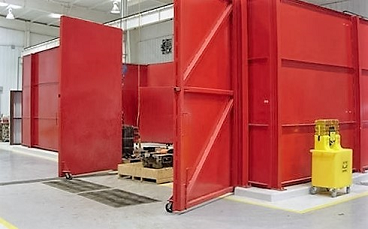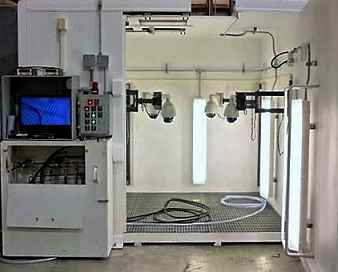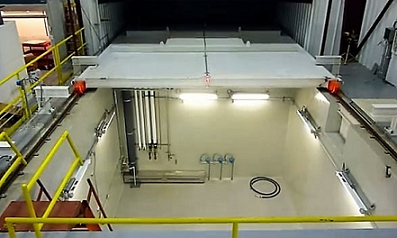High-Pressure Test Enclosures for Valve Assemblies
As drilling operations explore ever greater depths and pressures, operating pressures for new valve assemblies are going beyond traditional limits.
#pressure-relief #standards
The requirements for these complex assemblies are evolving and manufacturers are reaching the limits of current testing capabilities for components. This can include operations at extremes of temperature, pressure and flow. The safety issues associated with extreme testing simulation are not for the uninitiated. Uncontained events have the potential to be catastrophic, endangering equipment and personnel.
There are three basic types of test enclosures: Modular, Containment Pit and Portable.
Let's discuss some of the unique design challenges associated with each type. First, the most common type is a modular, steel frame design. These are called Modular Test Enclosures (MTE), because the basic design can be scaled based on size, pressure, and duty requirements.
- Maximum component size, including accessories and instrumentation
- Maximum component weight
- Fluids capability (i.e., hot oil)
- Maximum pressure
- Maximum temperature
- Corrosion environment
- Production volume
- Portability
Modular Test Enclosures
Modular Test Enclosures (MTE) are designed for low- to medium-pressure applications that require personnel protection from uncontained release events. The testing enclosure will have a unique set of safety requirements, procedures and routine tests to maintain its safe operation—which would be true of any large safety system. MTEs will generally accommodate simple pressure testing up to about 20,000 psi (1380 bar), depending on the size and complexity. Manufacturers want a design that accommodates their maximum production rate, so that testing does not become a “bottleneck” in the process flow. Above 20,000 psi (1380 bar), other design features and redundancies may be needed.
Ultra-High Pressure Enclosures
The designs are enhanced using hydraulically-actuated steel canopies to contain any possible vertical release. The side walls are designed with reinforced-concrete, and the surfaces are sealed. The design must accommodate possible fluid releases and include the capability for remedial cleanup.
Portable Test Enclosures
Another type, Portable Test Enclosures (PTE), are gaining interest due to their ability to be deployed into the field or into a smaller footprint-type working environment. They can be designed for small assemblies that can be manufactured and tested on-site, resulting in significant cost and schedule savings. Other capabilities such as torque and dyno measurements can be added to reduce test cell time and turnaround.
Given the increasing industry requirements for testing prior to service introduction, it is likely that many component manufacturers will require service-duty testing. Manufacturers find that providing this assurance to customers can prove beneficial for developing new designs and gaining market acceptance quickly. API 598, RP 591, ASME B16.34 and other industry standards are helping design teams to develop the best approach for engineered product solutions. Each solution can be a unique design based on needs and space requirements, even while the service-duty requirements may be similar. The next few years will be critical for the industry as it adapts to these changes and evolving engineering requirements.
Lee Pistell is a senior project manager and Wesley Dunn is a registered professional engineer at EMC Services. Owen Calvert is a registered professional engineer at IES Electric.
REFERENCES:
- American Petroleum Institute (API), Standard 598, Valve Inspection and Testing, September 2009. (under revision)
- American Petroleum Institute (API), Recommended Practice 591; Process Valve Qualification Procedure, 2014.
- American Petroleum Institute (API), Specification 6D, Specification for Pipeline and Piping Valves; August 2014.
- American Society of Mechanical Engineers (ASME) B16.34, Valves - Flanged, Threaded and Welding End; 2013.
- Canadian Standards Association (CSA) Z662-15: Oil and Gas Pipeline Systems; 2015.
- International Standards Organization, BS EN ISO 4413: Hydraulic fluid power – General rules relating to systems; 2011.
- High Pressure Testing Bunker; Lee Pistell, EMC Services, 2012. https://www.youtube.com/watch?v=Ft5CKjOMmPE
- Securing Manually Operated Testing Bunker; Lee Pistel, EMC Services, 2014. https://www.youtube.com/watch?v=-qx9AZSs0g4
- R&D High Pressure Testing Blast Containment Pit Cover; Lee Pistel, EMC Services, 2014. https://www.youtube.com/watch?v=T7JfTQ3hClo
RELATED CONTENT
-
Back to Basics: Pressure Relief Devices, Part 2
In Part 1 of Pressure Relief Devices, which appears in VALVE Magazine’s Winter 2016 issue, the author stresses the vital role pressure relief devices play in keeping end-user industries that deal with pressurized equipment safe.
-
Fundamental Operation of Pilot-Operated Safety Relief Valves
In this second of a series, we explore another type of pressure relief valves used in common applications.
-
The Rationale Behind Valve Characteristics
Back in the “early days,” we were taught that, to properly control flow, we should select a linear valve characteristic when the valve controls more than 25% of the piping system pressure drop at full flow.













 Unloading large gate valve.jpg;maxWidth=214)